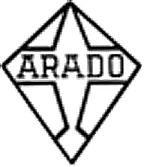Founder Hugo Stinnes | Founded 1925 | |
 | ||
Arado Flugzeugwerke was a German aircraft manufacturer, originally established as the Warnemünde factory of the Flugzeugbau Friedrichshafen firm, that produced land-based military aircraft and seaplanes during the First World War.
Contents
History
With its parent company, it ceased operations following the First World War, when restrictions on German aviation were created by the Treaty of Versailles. In 1921, the factory was purchased by Heinrich Lübbe, who is said to have assisted Anthony Fokker in the creation of the pioneering Stangensteuerung synchronization gear system during 1914-15, and re-commenced aircraft construction for export, opening a subsidiary, Ikarus, in Yugoslavia. Walter Rethel, previously of Kondor and Fokker, was appointed head designer.
In 1925, the company joined the Arado Handelsgesellschaft ("Arado trading firm") that was founded by the industrialist Hugo Stinnes Junior for covering up illegal trade with military equipment. When in 1933 the new Nazi government came to power in Germany, Stinnes emigrated and Lübbe took control of the company. Just prior to this, Walter Blume, formerly of Albatros, replaced Rethel.
Arado achieved early prominence as a supplier to the Luftwaffe with the Arado Ar 66, which became one of the standard Luftwaffe trainers right into World War II. The firm also produced some of the Luftwaffe's first fighter aircraft, the Ar 65 and Ar 68. In 1936, the RLM (Reichsluftfahrtministerium – "Reich Aviation Ministry") insisted that, as a show of loyalty, Lübbe should join the Nazi party. When he refused, he was arrested and forced to sell the company to the state. It was renamed to the more specific (and accurate) Arado Flugzeugwerke GmbH, and was placed under the direction of Erich Serno, and Felix Wagenführ, himself a former IdFlieg officer in World War I.
When Germany invaded Poland, instigating World War II, two more Arado products rose to prominence, the Ar 96, which became the Luftwaffe's most used trainer, and the Ar 196 a reconnaissance seaplane that became standard equipment on all larger German warships. Unfortunately for Arado, most of their other designs were passed over in favour of stronger products from their competitors, such as Germany's only heavy bomber fielded during the war, the Heinkel He 177, for which Arado was the primary subcontractor. Perhaps Arado's most celebrated aircraft of the war was the Ar 234, the first jet-powered bomber. Too late to have any real effect on the outcome of the conflict, it was nevertheless a sign of things to come.
Until their liberation in April 1945 by the Soviet army, 1,012 slave laborers from Freiburg, a sub-camp of the Flossenbürg concentration camp, worked at the Arado factory, beginning with the first trainload of 249 prisoners arriving in August 1944. The prisoners were mostly Polish Jewish women and girls sent to Freiburg from Auschwitz.
Arado also licence-built various versions of, and components for the Focke Wulf Fw 190.
In 1945, the company was liquidated and broken up.
The Ar 96 continued to be produced in Czechoslovakia by Zlin for many years after the war as the C.2B.
Aircraft
Arado aircraft include:
List of Major Internal Projects of the WW2 Era under the RLM:
